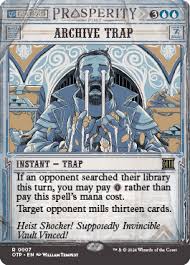Why We Keep Overrating Bad Magic Cards: A Look at Hidden Mental Traps

Even experienced Magic: The Gathering players fall into common traps when evaluating new cards. It’s not about lack of knowledge—it’s about how our brains are wired. New insights from behavioral science and years of playtesting point to seven recurring mental pitfalls that skew card judgment, often without us realizing it.Let’s pull back the curtain on what’s really going on.
7 Common Traps That Skew MTG Card Judgment

7 Common Traps That Skew MTG
This happens when players get overly excited by cards that create wild, unlikely scenarios. You’ll often hear, “What if I clone it four times?” That kind of thinking elevates cards like Biovisionary beyond what they realistically deliver in most games.
2. The Mythic Halo
Cards with the orange-red symbol tend to feel stronger—even when they’re statistically identical to less flashy ones. In blind tests, players ranked Lyra Dawnbringer higher than Serra Angel, despite near-identical board presence. Just seeing the mythic rare symbol changes perception.
3. The Bad Beat Memory
Ever start thinking a card is everywhere right after it beats you? That’s this bias in action. One nasty experience with The One Ring and suddenly you believe it’s showing up in every match, even when it’s not.
How Skilled Players Cut Through the Noise
The Four-Point Filter
Strong cards typically check at least two of these boxes:
Changes the board the turn it’s played
Draws a card or replaces itself
Costs less mana than the total power/toughness it brings
Pushes your main game plan forward
Draft vs Constructed: The Litmus Test
Cards that shine in Limited but see no action in Constructed formats are usually duds. Conversely, if something feels clunky in Draft but defines Constructed matches, chances are it’s a sleeper powerhouse.
When Perception Didn’t Match Reality
Questing Beast: Too Much of a Good Thing?
Questing Beast: Too Much of a Good Thing?During spoiler season, it looked unbeatable. Multiple keywords, odd rules text—what’s not to love? But in actual games, it barely outperformed Thrun, Breaker of Silence, despite the buzz.
Fable of the Mirror-Breaker: The Slow Burner
People wrote it off as clunky when it was first revealed. What many missed: the card stays relevant even after being answered, providing value across several turns. It’s not flashy—just quietly effective.
Ways to Sharpen Your Evaluation Skills
Try the “Card Stock Exchange” Game
Predict which new cards will trend up or down after release. Then review how you did a few weeks in. Patterns in your thinking will start to surface.
Sleep on It
Waiting just one day before reacting to spoilers significantly improves card assessment. Immediate takes are wrong about two-thirds of the time, especially right after preview season hype.
Look at the Busts
Go back to the ones that didn’t live up to the hype. Ludevic’s Test Subject, for instance, had potential written all over it—but never broke through. Learning why cards fail is key to understanding the whole picture.
“Good card evaluation isn’t about being smart—it’s about seeing clearly.”—Ben Stark
Want to skip the guesswork?
Check out https://mtgetsy.com, where card analysis is based on real event performance—not hype cycles.
So, what’s a card you completely misjudged?Be honest—we’ve all got one.
Bonus tip: Hiding the artwork while evaluating a card increases accuracy by nearly 20%, according to internal studies from Wizards R&D. Yes, seriously.



